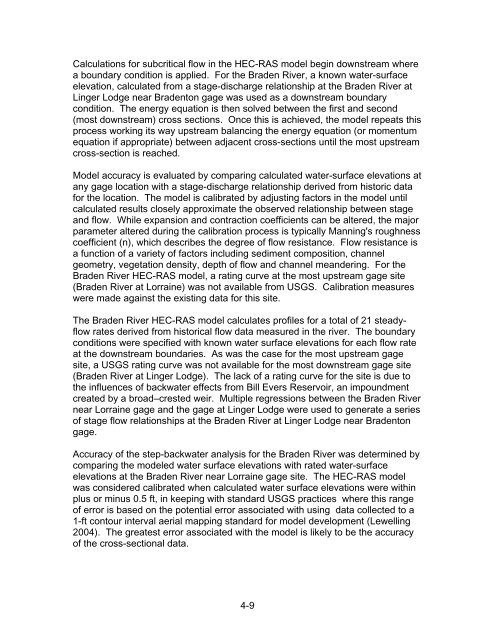Chapter 1 Minimum Flows and Levels - Southwest Florida Water ...
Chapter 1 Minimum Flows and Levels - Southwest Florida Water ...
Chapter 1 Minimum Flows and Levels - Southwest Florida Water ...
You also want an ePaper? Increase the reach of your titles
YUMPU automatically turns print PDFs into web optimized ePapers that Google loves.
Calculations for subcritical flow in the HEC-RAS model begin downstream where<br />
a boundary condition is applied. For the Braden River, a known water-surface<br />
elevation, calculated from a stage-discharge relationship at the Braden River at<br />
Linger Lodge near Bradenton gage was used as a downstream boundary<br />
condition. The energy equation is then solved between the first <strong>and</strong> second<br />
(most downstream) cross sections. Once this is achieved, the model repeats this<br />
process working its way upstream balancing the energy equation (or momentum<br />
equation if appropriate) between adjacent cross-sections until the most upstream<br />
cross-section is reached.<br />
Model accuracy is evaluated by comparing calculated water-surface elevations at<br />
any gage location with a stage-discharge relationship derived from historic data<br />
for the location. The model is calibrated by adjusting factors in the model until<br />
calculated results closely approximate the observed relationship between stage<br />
<strong>and</strong> flow. While expansion <strong>and</strong> contraction coefficients can be altered, the major<br />
parameter altered during the calibration process is typically Manning's roughness<br />
coefficient (n), which describes the degree of flow resistance. Flow resistance is<br />
a function of a variety of factors including sediment composition, channel<br />
geometry, vegetation density, depth of flow <strong>and</strong> channel me<strong>and</strong>ering. For the<br />
Braden River HEC-RAS model, a rating curve at the most upstream gage site<br />
(Braden River at Lorraine) was not available from USGS. Calibration measures<br />
were made against the existing data for this site.<br />
The Braden River HEC-RAS model calculates profiles for a total of 21 steadyflow<br />
rates derived from historical flow data measured in the river. The boundary<br />
conditions were specified with known water surface elevations for each flow rate<br />
at the downstream boundaries. As was the case for the most upstream gage<br />
site, a USGS rating curve was not available for the most downstream gage site<br />
(Braden River at Linger Lodge). The lack of a rating curve for the site is due to<br />
the influences of backwater effects from Bill Evers Reservoir, an impoundment<br />
created by a broad–crested weir. Multiple regressions between the Braden River<br />
near Lorraine gage <strong>and</strong> the gage at Linger Lodge were used to generate a series<br />
of stage flow relationships at the Braden River at Linger Lodge near Bradenton<br />
gage.<br />
Accuracy of the step-backwater analysis for the Braden River was determined by<br />
comparing the modeled water surface elevations with rated water-surface<br />
elevations at the Braden River near Lorraine gage site. The HEC-RAS model<br />
was considered calibrated when calculated water surface elevations were within<br />
plus or minus 0.5 ft, in keeping with st<strong>and</strong>ard USGS practices where this range<br />
of error is based on the potential error associated with using data collected to a<br />
1-ft contour interval aerial mapping st<strong>and</strong>ard for model development (Lewelling<br />
2004). The greatest error associated with the model is likely to be the accuracy<br />
of the cross-sectional data.<br />
4-9
















